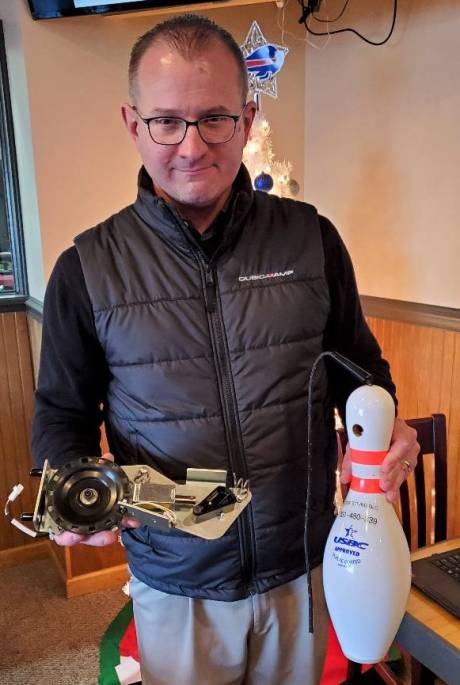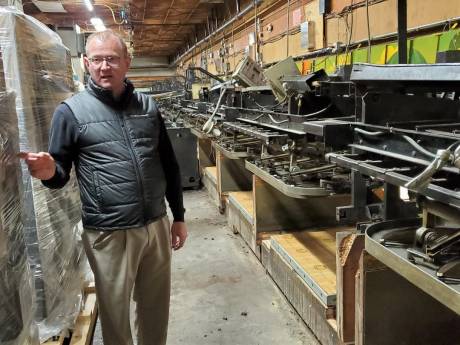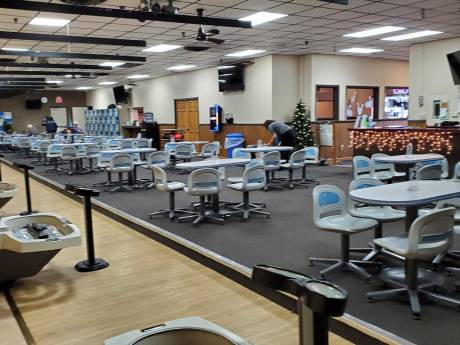
The owners of Livingston Lanes & Pub in Geneseo, a 16-lane establishment that is part of the Genesee Region USBC association, are in the process of installing string pinsetters – an investment approaching $250,000 they say is being made to keep the bowling center open for the foreseeable future.
The timing of the change, however, is resulting in the disruption of several leagues at Livingston Lanes that are certified by the United States Bowling Congress.
Since string pinsetters – yes, the bowling pins are attached to strings connected to a mechanical device that interfaces with the computerized scoring – have yet to be recognized by the USBC, averages of the bowlers in the affected leagues will be “final” as of the last time they bowl on the standard AMF pinsetters.
Dana Carson, one of four men who own the business, said they had hoped to wait until after the traditional league season, which ends in April, but were subject to the installers’ (QubicaAMF) work schedule.
“Unfortunately, with the timing of everything, it is midseason, but we weren't able to choose our time,” he said. “So, with COVID and getting employees to work and the subcontractors involved, there's a lot of different variables going on. So, again, unfortunately for the league bowlers, we had to do it now.”
COST SAVINGS A CRITICAL FACTOR
Carson said he and his partners have been concerned about the costs involved in keeping the current pinsetters running efficiently and have discussed removing the lanes and going in a different direction with that space. Previously, they spent a couple hundred thousand dollars in renovating the concourse, restaurant and bar area.
“They tell us that because of the mechanic and the parts issues that there is a long-term savings,” Carson said. “But with the initial investment, we figure it is the best fit for our open bowlers and our league bowlers right now … a way to speed up the pace of play.”
Bill Little, district sales manager for QubicaAMF, said string pinsetters require very little maintenance, eliminate the need for a mechanic and save considerably on electricity costs.
Little, whose office is in Philadelphia, spoke with The Batavian last week while overseeing the installation, which is expected to be completed sometime next week.
He said that Livingston Lanes is the seventh bowling center in his region to switch from conventional to string pinsetters.
“These machines, on average, will run about 7,000 frames per stop, where your traditional free fall machine may run for around 1,000 frames per stop,” he said. “So, you're not going to have as many mechanical breakdowns. Anybody that works in the bowling center on the staff can be trained on how to do all the maintenance that is involved -- how to repair them and how to work on them."
AN APP TO ASSIST WITH MAINTENANCE
He said the system includes an app on cell phones where a person can download something called Tech Wizard, which will notify via a text message when there’s a problem with a lane.
“It will say, ‘Hey, lane seven has this problem.’ They’ll acknowledge it on their phone and then they’ll have the ability to look at what to do on the phone as they’re walking back to the machine,” he said. “It will show them a video, give them the ability to write notes and the ability to see what tools they need – and there are only six tools required to work on these machines.”
Little said the process calls for completely removing the old pinsetter and installing QubicaAMF’s Edge string pinsetter, which have very few moving parts. He said the equipment is a redesign of an old German machine that has been in existence for about 40 years.
While the initial cost is comparable to a free fall pinsetter, the maintenance costs are much less, he said.
“They cost only $12 per year per machine in electricity and the two 24-volt DC motors only run when there’s a call to action for the motor to run … not continuously like they do on these machines now,” he said. “And the parts’ cost savings is tremendous. You don’t need to spend $500 per machine per year on parts.”
The Edge string pinsetters are designed for competition, Little said.
LITTLE: NOT AN ARCADE GAME
“This is not an arcade game. It’s a very authentic experience to free fall. The back and the kickbacks are all black so you don’t really see the strings that much,” he said. “And the pinfall is very similar in some of the tournaments that we had and some of the tests that we've had with people bowling on them -- especially PBA (Professional Bowlers Association), male and female. That pin difference is like 1.3 pins (per game).”
Little noted that the pin itself is the same pin as used in conventional pinsetters “except it has three holes drilled at the top to put the string on it.”
“Other than that, it’s the same bowling pin – weighing 3 pounds, 6 ounces to 3 pounds, 8 ounces.”
The USBC Equipment & Specifications Team has been conducting tests on string pinsetters and is not at a point where it is ready to certify them for competition. Talk out of USBC headquarters in Arlington is that when they are certified, it would likely be a separate division along the lines of Standard, Challenge and Sport condition levels that exist today based on how the lanes are oiled.
After its most recent study in September 2021, the USBC identified several factors affecting pinfall, including string length, pin curtain, ball stop cushion and kickback thickness.
Adjustments were made to the string length, pin curtain location and ball stop cushion until results approached those of free-fall machines, and a design of experiment was conducted to identify the best combination of these properties to reduce the rate of splits being converted due to interference from the strings.
Videos on YouTube show a bowler converting the 2-8-10 split, for example, by hitting the 10 pin and seeing that pin bounce out of the pit to hit the 8 into the 2. That’s something that would never happen on conventional pinsetters.
HOPING BOWLERS WILL HANG IN THERE
It’s practically a certainty that the USBC will certify string pinsetters – likely before next fall – to avoid the possibility of losing out on membership revenue.
For bowlers seeing string pinsetters coming into their “houses,” especially in midseason as is the case in Geneseo, decisions on whether to bowl on the new apparatus or to quit have to be made.
Carson, a retired Geneseo Police Department officer, said he hopes that his bowlers will understand the situation at Livingston Lanes and keep bowling.
“We’re looking forward. People get second and third chances out here, but we’re looking for people to give us just one chance,” he said. “We’ve done a lot already. When COVID first shut us down, we decided to do a major renovation for the bar and restaurant. That’s two major projects that we're able to do as a small business during COVID. So, I think people and I think our league bowlers will appreciate that.”
Click HERE to watch the video summary of USBC's second research report on string pinsetters from September 2021.
Photo above: Bill Little, district sales manager for QubicaAMF, displays a string pin and mechanism that controls it, while at Livingston Lanes in Geneseo last week.

Little points to a box containing a string pinsetter that will replace the conventional AMF pinsetters at the Geneseo bowling center.

The remodeled concourse at Livingston Lanes. The bar/restaurant is located behind the windows in the background. Photos by Mike Pettinella.
